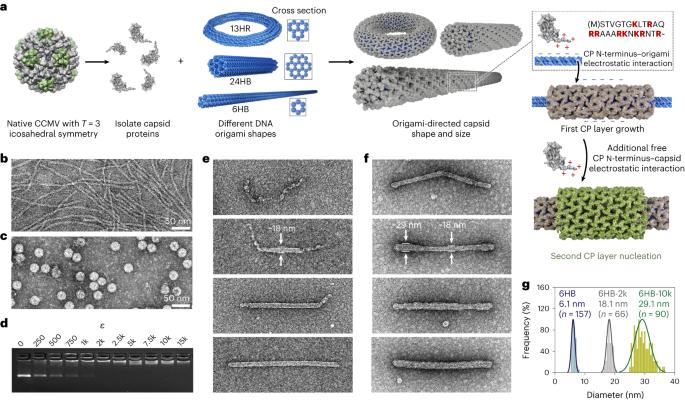DNA折纸引导的病毒衣壳多态性。
IF 38.1
1区 材料科学
Q1 MATERIALS SCIENCE, MULTIDISCIPLINARY
引用次数: 0
摘要
病毒衣壳可以采用各种几何形状,最典型的特征是二十面体或螺旋对称性。重要的是,精确控制病毒衣壳的大小和形状将有利于开发新的疫苗和递送系统。然而,目前以可编程方式指导组装过程的工具是极其难以捉摸的。在这里,我们介绍了一种模块化方法,通过证明DNA折纸引导的单个蛋白质亚基衣壳的多态性。我们通过使用用户定义的DNA折纸纳米结构作为结合和组装平台来实现对衣壳形状、大小和拓扑结构的控制,这些结构被有效地封装在衣壳内。此外,所获得的病毒衣壳涂层可以保护包封的DNA折纸不被降解。此外,我们的方法不仅限于单一类型的囊泡,还可以应用于RNA-DNA折纸结构,为下一代货物保护和靶向策略铺平道路。本文章由计算机程序翻译,如有差异,请以英文原文为准。

DNA-origami-directed virus capsid polymorphism
Viral capsids can adopt various geometries, most iconically characterized by icosahedral or helical symmetries. Importantly, precise control over the size and shape of virus capsids would have advantages in the development of new vaccines and delivery systems. However, current tools to direct the assembly process in a programmable manner are exceedingly elusive. Here we introduce a modular approach by demonstrating DNA-origami-directed polymorphism of single-protein subunit capsids. We achieve control over the capsid shape, size and topology by employing user-defined DNA origami nanostructures as binding and assembly platforms, which are efficiently encapsulated within the capsid. Furthermore, the obtained viral capsid coatings can shield the encapsulated DNA origami from degradation. Our approach is, moreover, not limited to a single type of capsomers and can also be applied to RNA–DNA origami structures to pave way for next-generation cargo protection and targeting strategies. DNA and RNA origami nanostructures direct the size, shape and topology of different virus capsids in a user-defined manner while shielding encapsulated origamis from degradation.
求助全文
通过发布文献求助,成功后即可免费获取论文全文。
去求助
来源期刊

Nature nanotechnology
工程技术-材料科学:综合
CiteScore
59.70
自引率
0.80%
发文量
196
审稿时长
4-8 weeks
期刊介绍:
Nature Nanotechnology is a prestigious journal that publishes high-quality papers in various areas of nanoscience and nanotechnology. The journal focuses on the design, characterization, and production of structures, devices, and systems that manipulate and control materials at atomic, molecular, and macromolecular scales. It encompasses both bottom-up and top-down approaches, as well as their combinations.
Furthermore, Nature Nanotechnology fosters the exchange of ideas among researchers from diverse disciplines such as chemistry, physics, material science, biomedical research, engineering, and more. It promotes collaboration at the forefront of this multidisciplinary field. The journal covers a wide range of topics, from fundamental research in physics, chemistry, and biology, including computational work and simulations, to the development of innovative devices and technologies for various industrial sectors such as information technology, medicine, manufacturing, high-performance materials, energy, and environmental technologies. It includes coverage of organic, inorganic, and hybrid materials.
 求助内容:
求助内容: 应助结果提醒方式:
应助结果提醒方式:


